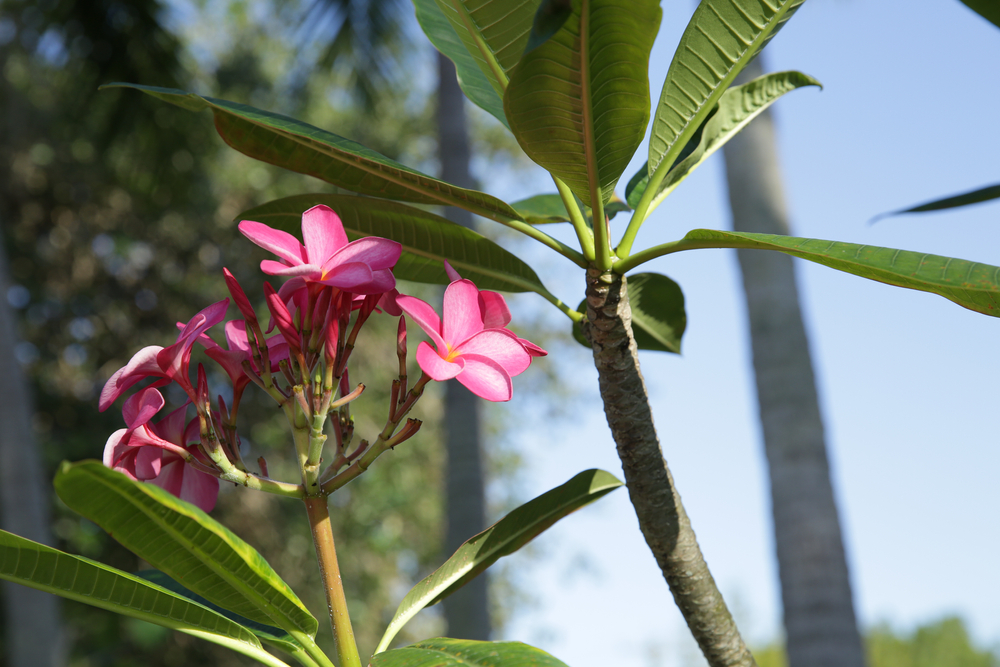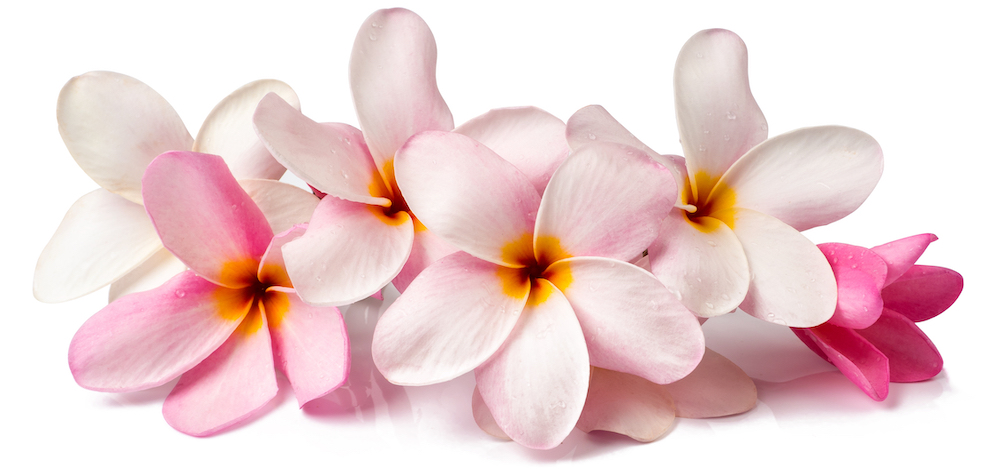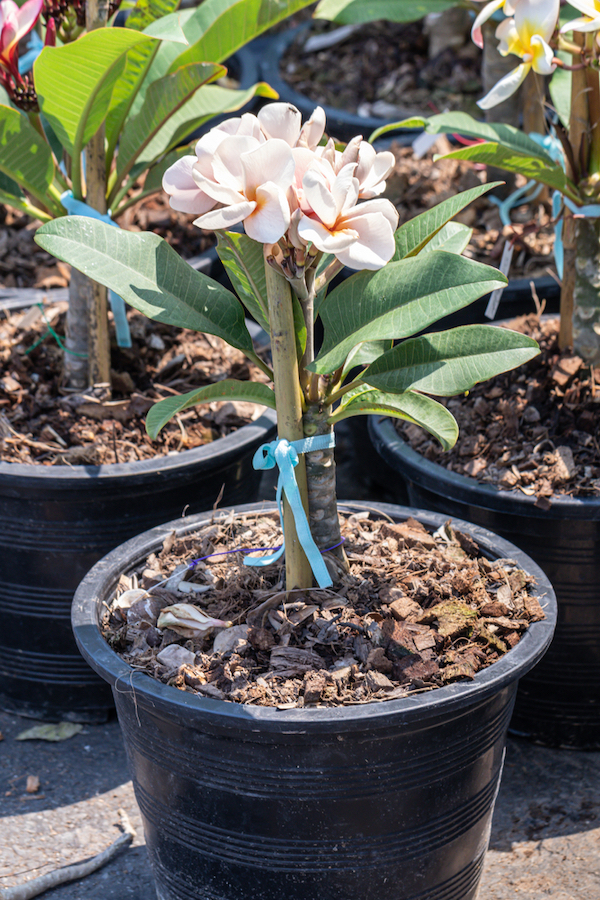If this quarantine has you dreaming of a getaway, you can bring a bit of tropical paradise home by planting plumeria – the classic flowering tree that evokes visions of hula dancers, cocktails, and ukuleles on warm Hawaiian sands. But you don’t need to go that far to get that vibe.
If you plant it correctly – and soon – you will be enjoying the fragrant flowers throughout the summer. And, as if you need more reasons to love plumeria, here’s two: they are simple to care for and are easy to propagate from simple stem cuttings.

Celebrating a Tropical Heritage
Plumeria, or Frangipani (Plumeria rubra), is a small flowering tree known for its beautiful, fragrant flowers and peculiar sausage-like branching habit. Though associated with luaus and the Polynesian Islands, it is native to Mexico and the Caribbean.
Typically, this compact tropical beauty does not require a large backyard – even a large pot can accommodate its growth. And bonuses! Plumeria thrive even with the presence of salt in the sea breeze, and is drought-tolerant, meaning it can go for long periods of time without water.
If you love the look of plumeria but feel it’s still a bit too large for you, check out its petite cousin, the Bridal Bouquet (Plumeria pudica), which is more compact and produces white flowers. As the name suggests, this variety of plumeria is used to create the ceremonial lei for the bride on her special day.

Making the Cut: Propagating from Stem Cuttings
During the next few months, brilliant clusters of yellow, pink, orange, red and white plumeria flowers are going to be on full display here, signaling the perfect time to grow your own. If you are interested in growing your own plumeria, you may find them at open nurseries and home stores for purchase, or you can order online (www.etsy.com has more than a few options).
Have a friend or neighbor with a beautiful tree? Ask them for a stem cutting or two. The spring and summer months are the perfect time to take cuttings from a plumeria as the warm, moist weather prompts healthy growth. It doesn’t make a difference where you cut to start your cutting along a branch, as long as your pruners are sharp and clean. Use your pruners to make a downward angle cut to reduce the likelihood of introducing rot to the naked end. As easy as plumeria are to care for, they do tend to be prone to fungi, no matter the season. You can decrease the chances of introducing unwanted fungus by sterilizing your pruners and removing leaves from the plant in the late fall that have orange colored rust spots on their backsides.
To successfully prepare a cutting, you must allow it to completely dry out over a period of a day or two, the latter a safer move. A moist cutting is just asking for fungi (rot) to move in, and that will not get things off to a great start.

Next, remove all the leaves from the stem. This will entice the plant to start putting energy into making roots instead of leaves that are no longer useful.
Using a smaller pot, 4 to 6 inches in diameter, makes it easier to gauge water needs, ensuring you don’t overwater the stem. For your potting soil, you can DIY your own blend of equal parts sand, perlite, and potting soil (I recommend Foxfarm Happy Frog), or you can use premade succulent soil with similar results. For optimal results, using a rooting hormone powder, such as Dip n’ Grow, can help get things started easier. Simply dip your cutting into the solution, shaking off the excess before placing it into a premade hole formed by your fingers. Pack the soil around the stem until it is able to stand upright without support and water it in. Our swampy Florida conditions, the perfect mix of humidity and warm temperatures, will help the roots develop within two to four weeks of cutting. After that, you can move it to a bigger pot or plant it directly into your yard.
Stringing a Plumeria Lei
This is a fun and easy project that delivers beautiful, fragrant results! All you need to get started are a few dozen flowers, kitchen twine, a large eyed sewing needle, and a free afternoon! If you’ve got kids at home looking for something to do, put them to work! With only five simple steps, this is an activity that everyone can get in on.
- Measure out a long enough piece of twine to create a necklace that falls midway down your chest.
- Collect the flowers and cut at the stems, leaving at least ¼ inch of stem intact.
- Take a threaded needle and push through the stem at the back of the flower, up through the face of the flower, until the twine comes through. Most of the time, they will go on cleanly… however, there are always a few casualties that end up splitting so it’s a good idea to have extra on hand. For a full length 40” lei, around 50 medium flowers are needed.

- Line them up nicely so they are all facing the same direction. Continue with the rest of your flowers, or until the end of the string is filled.
- Tie off the ends of twine making sure the necklace can be placed around the wearer’s head without untying.
- Enjoy! Leis will stay looking fresh for two days.
Enjoy your tropical lei, even if it’s more of an escape than a vacation! With our beautiful summer weather, the right tropical drink, and a classic plumeria lei, you might just find paradise is closer than you think.

Amanda Rose Newton
Amanda Rose Newton is a Florida certified horticulture professional; board certified entomologist, beekeeper, and educator. She holds an Associates of Science in Horticulture Technology, A Bachelor of Science in Biochemistry, a Master’s of Science in Entomology with a specialization in Integrated Pest Management, and is currently pursuing a Doctorate at Florida Institute of Technology.











